This conference will have a day where participants can join an organized field trip. Field trips will occur on June 7th, and most will start around 8 AM. Closer to the field trip, we will share the meeting location.
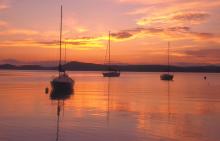
|
1. Lake Champlain Cultural and Natural HistoryIn this trip, we'll look at the cultural, archaeological and natural history of Vermont's largest lake, At 110 miles long, Lake Champlain is both a transportation corridor and a barrier to human and animal movement. We'll explore the historical significance of this beautiful place and hear from biologists about ongoing studies to understand its ecology. We'll make stops at the Lake Champlain Maritime Museum, the Champlain Bridge and Mt Independence. Mt. Independence is the most intact Revolutionary War site in the US. This is a bus trip with several stops focused on the cultural, archaeological and natural history of Vermont's largest lake. The group will have opportunities to walk around at several stops (up to 2 miles). Water and lunch will be provided but please bring a refillable water bottle if you are able. A backpack, sunblock, bug spray, and rain coat are also advisable. We’re looking forward to a great trip. |
1. I-25 Front Range Wildlife Crossings and Riparian Mitigation (Full Day)The widening of I-25 between the state's two largest cities created the opportunity to reconnect habitat between the plains and foothills ecosystems, and the Environmental Assessment process identified wildlife-vehicle collisions as a safety problem for motorists and the interstate as a barrier to wildlife movement and population health. Douglas County supports the largest protected open space along Colorado's Front Range - the result of proactive planning efforts for over 40 years. This stretch of I-25 now boasts a comprehensive wildlife mitigation system with five large underpasses for elk, mule deer, black bears, mountain lions, and other wildlife. Each crossing also includes a habitat features to provide cover for small fauna, including the federally threatened Preble's meadow jumping mouse. In 2023, CDOT received funding through the first round of FHWA's Wildlife Crossing Pilot Program to construct the final piece of the mitigation system - a 200'-wide overpass spanning 6 lanes of interstate. Field trip participants will hike through Douglas County's Greenland Open Space to view the overpass construction, which will be underway. The final stop on the field trip will be to Plum Creek Bridge - a large, multi-span bridge which supports floodplain management, wildlife passage, and includes a regional recreation trail off-set to one side. Participants will also visit the beaver dam analogs, which were constructed to improve Preble's mouse habitat, restore groundwater elevations in Carpenter Creek and East Plum Creek, generate riparian habitat, and encourage beaver recolonization. This trip is recommended only for people who are comfortable hiking 4-5 miles total on rolling terrain (elevation 6,700'). Please bring a small pack with plenty of water, snacks, warm layers, and sun protection. Additional water, snacks, and a box lunch will be provided. |
|

|
2. Reptiles and Amphibians of VTIn this hands on excursion, participants will explore wetlands and vernal pools in southern Addison County looking for a variety of Vermont's amphibian and reptile species including, wood frogs, spotted salamanders, eastern musk turtle, painted turtle, and snapping turtle. We'll visit wetlands in the Pond Woods Wildlife Management Area, a successful salamander crossing structure and a road segment that is in design for a series of snake crossings. The trip will involve about 1.5 miles of hiking. Expect to be moving around wetlands where rubber boots are recommended for versatility but not required. This is a bus trip with several stops focused exploring wetlands and vernal pools in southern Addison County looking for a variety of Vermont's amphibian and reptile species including, wood frogs, spotted salamanders, eastern musk turtle, painted turtle, and snapping turtle. The group will have opportunities to walk around at several stops (up to 2 miles). Water and lunch will be provided but please bring a refillable water bottle if you are able. A backpack, sunblock, bug spray, and rain coat are also advisable. The conference will be providing an orange vest to each participant. We ask that you wear the vest as several stops will be in proximity to the road. We’re looking forward to a great trip. |
2. US 34 Big Thompson Flood Resiliency and Stream Restoration (Full Day)When severe rains hit the Front Range in 2013, flooding through the constrained Big Thompson Canyon washed out major sections of US 34, mimicking failures that had occurred 37 years prior in the 1976 floods. CDOT undertook an emergency repair effort to reopen the road within 3 months, then undertook longer term permanent repairs emphasizing full restoration and resiliency. The scale of this project required substantial innovation and collaboration between CDOT, FHWA, US Forest Service, US Army Corps of Engineers, Colorado Parks and Wildlife, FEMA and consultant teams. The collaborative response to this crisis situation won multiple design and emergency management awards. This field trip will highlight pre-flood conditions, the immediate response effort, post-flood resiliency and stream restoration work, and long-term monitoring efforts, including fish and macroinvertebrate populations. During the tour, attendees will learn about the 1976 flood and how roadway damages associated with that flood mimicked the 2013 flood and how the importance of considering river dynamics, functions, and needs during the final post-flood design and construction of the river and roadway after the 2013 flood. Highlights will include locations where a fish barrier, the Idlewild Reservoir and dam was removed, resulting in fish passage between lower reaches of the Big Thompson and upper reaches of both the Big Thompson and North Fork of the Big Thompson. Attendees will also learn how the river has recovered in terms of both populations and health of fish and macroinvertebrates, comparing pre-flood and final post-construction sampling results. To wrap up the tour, guests will receive CDOT's publication of "The River and the Road," a book dedicated to the people who lost their lives during the Big Thompson Canyon folds of 1976 and 2013. It's a story of the enduring struggle to forge and maintain a transportation connection through the Big Thompson Canyon to Estes Park, constructed more than 100 years ago. |
|
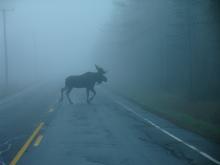
|
3. Moose and their Habitat in VTMoose are an iconic Vermont species. Motorists, cyclists and hikers may be lucky enough to experience this majestic animal standing shoulder deep in roadside wetlands seemingly unconcerned, or unfortunate enough to see a dark, hulking shape in the middle of a rural road in the middle of the night. Participants in this trip will learn more about moose biology and ecology and will stop at several locations of prime moose habitat in Groton State Forest including; Osmore Pond, the Groton Nature Center and Seyon Ranch. Be prepared to hike about 1.5 miles. This is a bus trip with several stops focused on moose and their habitat. These sites are likely to be buggy with black fly and mosquito. Trip leaders will have some bug spray but we recommend bringing your own. Even bringing a head net wouldn’t be too much! The group will have opportunities to walk around at several stops (up to 2 miles). Water and lunch will be provided but please bring a refillable water bottle if you are able. A backpack, sunblock, and rain coat are also advisable. We’re looking forward to a great trip. |
3. Rocky Mountain National Park (Full Day)Visit one of the country's most iconic national parks. Pack your comfortable snow boots and warm clothes for this one! Depending on the weather, this tour could take you to elevations nearing 9500'. RMNP will likely still be a winter wonderland at this time of year which lends itself for picturesque snowcapped mountain views and breathtaking vistas. With elk, bighorn sheep, mule deer, moose and a small population of black bears calling the park home, some unique wildlife viewing opportunities may arise - have your cameras at the ready. We’ll start our day the Beaver Meadows Visitor Center and move on to an outdoor amphitheater overlooking Moraine Park where park staff will discuss several science and resource management projects. We will then wind our way up the Bear Lake corridor where a short walk on an easy trail will be an option. The itinerary may change a bit depending on weather and on the ground conditions, but we’ll learn about this incredible place from the experts and see beautiful sights no matter the schedule. Lunch will be provided. |
|
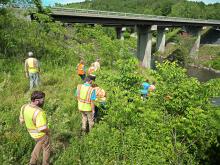
|
4. Road Crossings in the NortheastThe Vermont landscape of scattered quaint villages and rural countryside represents a special context for wildlife road crossings. Scattered driveways and far flung housing limit many crossing opportunities and significant flooding events are on the rise in the face of a changing climate. These create both challenge and opportunity as Vermont looks to focus on a statewide system of bridges and culverts that meet multiple values including flood resilience, aquatic organism passage and terrestrial wildlife movement. Route 12 passes through a large area of conservation concern and action. On this exciting road tour, participants will see under-bridge wildlife shelves, culvert replacements and floodplain restoration sites exemplifying our approach. This is a bus trip with several stops focused on habitat connectivity opportunities undertaken on the central Vermont landscape. The group will have opportunities to walk around at several stops (up to 1 mile). Water and lunch will be provided but please bring a refillable water bottle if you are able. A backpack, sunblock, bug spray, and rain coat are also advisable. The conference will be providing an orange vest to each participant. We ask that you wear the vest as several stops will be in proximity to the road. We’re looking forward to a great trip. |
4. I-70 Mountain Corridor: Genesee to Georgetown Wildlife Crossings (Full Day)Join us for a tour of major wildlife crossing zones on the I-70 Mountain Corridor as it winds up from the outskirts of Denver, through the foothills and towards the Continental Divide. This field trip will showcase Colorado's newest wildlife crossing - double span bridges under six lanes of interstate designed to reduce collisions and provide a safe passageway for elk, mule deer, and other wildlife. This site also features the state's first installation of a permanent monitoring system connected to fiber optic cable and power. Denver Mountain Parks manages a bison herd adjacent to this site and was an important partner in coordinating the highway fence design with the bison enclosure. We will stop at a park to hear about this coordination and to view the iconic American bison. The tour will then proceed up the I-70 Mountain Corridor to the site of a planned bighorn sheep overpass. This stop will feature the partnership with Colorado Parks and Wildlife to expand the State Wildlife Area to protect the habitat adjacent to the overpass and the multitude of design considerations that had to be addressed in this rocky, complex terrain. Our final stop will take us into the historic mining town of Georgetown and Georgetown Lake, where we may have the opportunity to see bighorn sheep on the steep hillsides above I-70. |
|
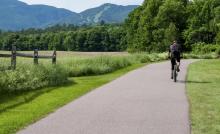
|
5. Vermont’s Cultural and Natural History -- BIKE TRIPIn this unique trip, we'll explore Vermont's cultural and natural history BY BIKE! As many of you know, usually our field trips are by bus. This time we will give the bus and climate a break and bike-trip. Participants can bring their own bike, or rent nearby. We will explore the Island Line bike trail along the shores of beautiful Lake Champlain. We'll see how 460 million years of geologic history have shaped the Vermont landscape and created a unique ecological stage for our people and transportation system. We'll stop along the bike path to see carnivorous plants in Colchester Bog, geologic layering that is evidence of plate tectonics, the Winooski river delta and an old rail causeway that allows cyclists out into the middle of the lake. Participants will bike approximately 15 miles on mostly flat, paved bike trail that is separate from the road network. The bike trip is focused on how 460 million years of geologic history have shaped the Vermont landscape and created a unique ecological stage for our people and transportation system. As you may recall from the registration materials, this will involve biking 15 miles on Burlington’s Island Line bike trail. Participants can bring their own bike, but rentals will be provided. Please be ready to go (with you bike if you’re bringing one) by 8:45 a.m. on Wednesday June 7th in the Hotel lobby. Please bring
Please do NOT wear clip-in bike shoes that will make it difficult to walk. We will be leaving the locked bikes on occasion and need to walk (up to a ¼ mile) to get to a stop. The rental bikes come with helmets and bike locks. If you bring your own bike, please bring your own helmet. The conference will be providing bag lunches that we will each be carrying on the trip. Trip leaders will have a small amount of extra room to carry gear that others can’t, but please be as prepared as you can. Trip leaders will be carrying some basic bike repair tools and tubes and a first aid kit. Please let us know if you have any concerns. We are looking forward to a great adventure! |
5. State Highway 9 & I-70 East Vail Pass: Locally-driven Wildlife Crossings Projects (Full Day)This field trip will highlight the power of diverse partnerships in supporting CDOT to construct wildlife connectivity and vehicle-collision reduction projects. State Highway 9 in Grand County is the site of Colorado's first comprehensive wildlife mitigation system, including the state's first two wildlife overpasses, four large underpasses, and 10 miles of fenced highway. This high elevation sagebrush valley is essential winter range for multiple populations of mule deer, as well as elk, moose, pronghorn, bighorn sheep, and variety of carnivores and other fauna. A 5-year monitoring study of the mitigation system documented over 100,000 successful passages by 17 large and medium-sized species and resulted in a 90% reduction in wildlife-vehicle collisions. This project would not have happened without the leadership of a local conservation ranch and surrounding communities, which raised nearly $10M for the project. In neighboring Summit County, I-70 over East Vail pass has long been identified as a major barrier to wildlife movement through the White River National Forest. The partnership organization, Summit County Safe Passages, is raising the funds to complete the designs for a system of wildlife crossings with fencing tying into existing bridges to reduce collisions with wildlife and enhance connectivity across the interstate. CDOT, Summit County, and Summit County are working together to raise the necessary funds to construct this important connectivity infrastructure project. The trip will include stops at State Highway 9’s north overpass, Colorado’s first; the SH9 Harsha underpass; lunch (provided) at Lake Dillon; a stop in the I-70 East Vail Pass where wildlife crossings are planned; and the Vail Pass Rest Area. |
|
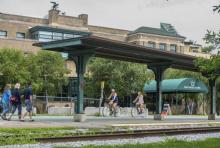
|
6. Land Use & Transportation Planning in BTV (Half-Day)In this half-day walking tour around Burlington, participants will meet with city planners and Department of Public Works professionals to learn more about the City's efforts to invest in bike/ pedestrian infrastructure and utilize rail that brings freight and passenger service into our city center. We'll see the City's railyard and train station that now connects Burlington with New York City and Montreal (with a bus connection) as well as our bike network and other planning efforts. Participants should expect to walk for about 2 miles on city sidewalks. This is an afternoon (half/day) walking trip with several stops focused on land use planning and multi-modal transportation issues facing Vermont’s largest city. The group will walk to stops around the city (approximately 2 miles of walking) on city sidewalks. Please bring a refillable water bottle if you are able. A backpack, sunblock, bug spray, and rain coat are also advisable. We’re looking forward to a great trip. |
6. Rocky Mountain Arsenal National Wildlife Refuge Wildlife and Birding (Half Day)Rocky Mountain Arsenal is one of the country's largest urban wildlife refuges and boasts expansive views of the Rocky Mountain skyline. The Arsenal is a success story in environmental remediation and prairie grassland ecosystem restoration following its history as a chemical weapons manufacturing facility from WWII through the Cold War. Today, the Refuge is home to thriving populations, including reintroduced populations of bison and black-footed ferrets, as well as deer, prairie dogs, roosting bald eagles, burrowing owls, hawks, songbirds, and waterfowl. This field trip will get an early start for the best wildlife and bird viewing. Participants should be prepared to walk up to 5 miles. Please bring plenty of water, warm layers, sun protection, and binoculars. Additional water and snacks will be provided. |
|
7. I-70 Central Cover Park, 47th & York Pedestrian Bridge Tour and Heron Pond Open Space Carpio-Sanguinette Park (Half Day)The I-70 Central Corridor in Denver is one of Colorado's economic backbones. It is home to 1,200 businesses and provides the regional connection to Denver International Airport, carrying upwards of 200,000 vehicles per day. The Central 70 Project reconstructed a 10-mile stretch of I-70 between Brighton Boulevard and Chambers Road, added one new Express Lane in each direction, removed the aging 57-year-old viaduct, lowered the interstate between Brighton and Colorado Boulevards, and constructed a 4-acre park over a portion of the lowered interstate. CDOT made a number of commitments to the local community - identified as one of the most polluted zip codes in America - as part of this project, which focused on mitigating the impacts of construction noise and dust to contributing funding to affordable housing and fresh food access. Participants will also visit Heron Pond Open Space and Carpio-Sanguinette Park, Denver's first designated Natural Area. Once a repository for smelting and other industrial by-products, it is now a restored native habitat and stormwater treatment wetland representing years of community investment and collaboration. Project partners worked together and closely engaged the community using non-traditional outreach techniques to undertake a major restoration and rehabilitation project to create a safe and useable community open space. Master Planning for the park was completed in 2017 and construction is occurring in multiple phases and will still be in progress during the field trip. In addition to site remediation and native habitat restoration, the park is on track to achieve SITES certification. The park will feature an experiential habitat trail, green stormwater infrastructure, amphitheater, picnic pavilion, playground, trails, and an overlook to the pond and surrounding wetlands, with educational signage in English and Spanish. The new park offers underserved, urban residents new ways to enjoy the outdoors and connect with nature in their community. This is a shorter field trip located in the heart of Denver not far from the hotel. The field trip visits the “CAP” project, where a 4-acre park was constructed over a lowered interstate-70 where it passes through an under-served community impacted by pollution. Expect some walking on mostly flat, paved roads of less than a mile in total. Snacks and water will be provided. |
